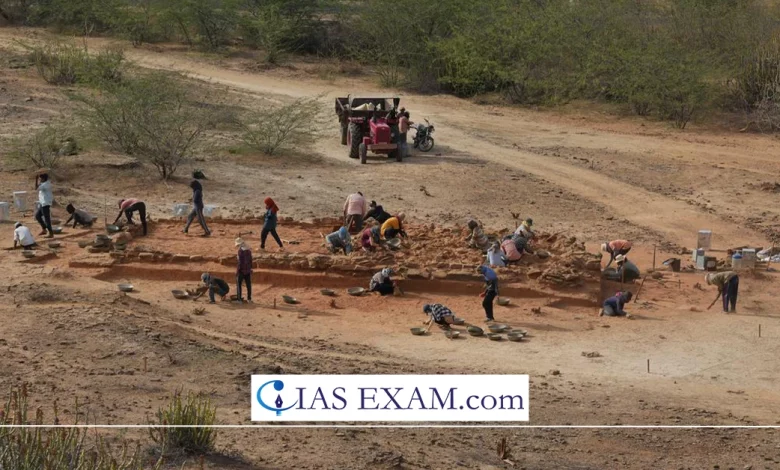Daily Current Affairs for UPSC
Evidence of Harappan Settlement in Kachchh
Syllabus- Ancient History [GS Paper-1]

Context
A human skeleton, pottery artifacts and animal bones belonging to Harappan Settlement has been found on the slope of a hillock in Kachchh, Gujarat.
About
- Archaeologists excavated a site called Padta Bet, it was 1.5 km from the mass burial ground of Juna Khatiya, an Early Harappan necropolis.
- In 2018, archeologists had unearthed a mass burial site with 500 graves on the outskirts of Khatiya village in Gujarat’s Kutch district which raised the questions of whose graves are those.
- The recent find bolsters the theory that the graveyard site may have served as a common facility for a cluster of several such smaller settlements.
- The Archaeologists additionally determined semi valuable stone beads fabricated from carnelian and agate, terracotta spindle whorls, copper, lithic equipment, cores and debitage, grinding stones and hammer stones.
Harappan Civilization
- The Harappan civilization is considered to be one of the oldest world civilizations along with Egypt and Mesopotamia.
- It was developed alongside the river Indus and because of this it is also known as the Indus Valley Civilization.
- The Harappan civilization is recognized as a Bronze-age civilization as most items have been found that are made up of copper based alloys.
Major Features of Civilization
- Urban Planning: Their towns had been properly deliberate and they had brick houses which have been situated alongside the roads.
- Every residence was equipped with a staircase, a kitchen and several rooms.
- Their courtyards had wells, lavatories and that they had right drainage systems.
- Ornaments: The Harappans wore ornaments made of gold, silver, ivory,shell, clay, semi-precious stones and others.
- Trade and Commerce: The civilization had significant trade networks, achieving as far as Mesopotamia, Afghanistan, and the Arabian Peninsula.
- Religion and Iconography: Harappan artifacts depict numerous symbols and motifs believed to be related to religious beliefs.
- These include figures which include the “Priest King” and pics of animals like bulls, suggesting feasible reverence for certain animals.
- Craftsmanship and Artistry: The Harappans produced intricate pottery, such as the well-known red pottery with black painted motifs.
- They also created jewelry, sculptures, and seals fabricated from steatite, terracotta, and different substances.
- Agriculture: They cultivated crops which include wheat, barley, peas, and cotton.
- Social Organization: The society became possibly stratified, with proof suggesting a hierarchical shape. This is indicated by versions in housing sizes and the presence of public places.
- Decline and Disappearance: The reasons for the decline of the Harappan Civilization are nevertheless debated between historians and archaeologists.
- Possible elements include ecological adjustments, together with shifts in river guides, in addition to invasions and internal conflicts.
Major Harappan Sites
| Site | Present Day |
| Harappa | Punjab, Pakistan |
| Mohenjo-Daro | Sindh, Pakistan |
| Dholavira | Kutch district of Gujarat |
| Kalibangan | Rajasthan |
| Lothal | Gujarat |
| Rakhigarhi | Haryana |
| Chanhudaro | Sindh, Pakistan |
| Ganweriwala | Punjab, Pakistan |
| Sutkagendor | Baluchistan Province, Pakistan |
| Alamgirpur | Uttar Pradesh |
Source: The Hindu
UPSC Prelims Practice Question
Q.Regarding the Indus Valley Civilization, consider the following statements:(2011)
- It was predominantly a secular civilization and the religious element, though present, did not dominate the scene
- During this period, cotton was used for manufacturing textiles in India.
Which of the statements given above is/are correct?
(a) 1 only (b) 2 only
(c) Both 1 and 2 (d) Neither 1 nor 2
Ans – (c)





.png)



